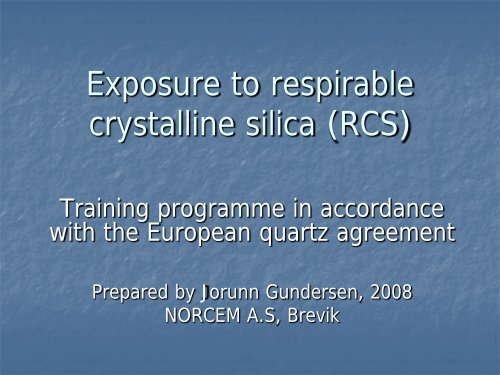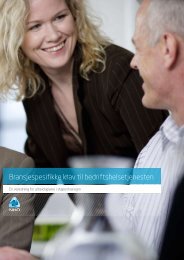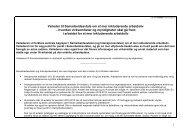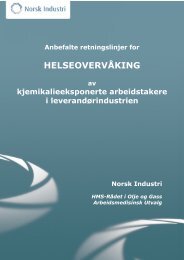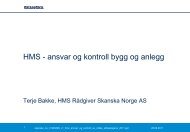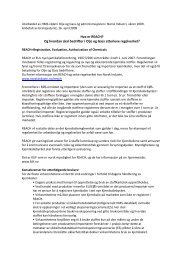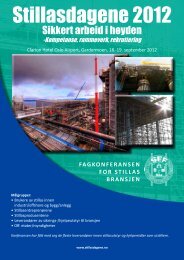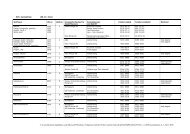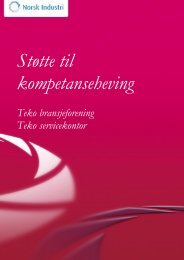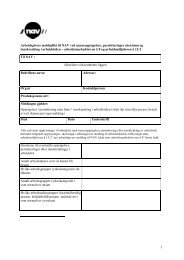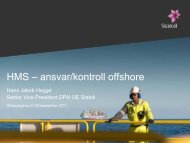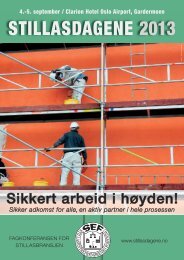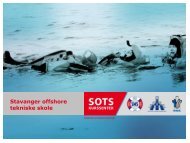Exposure to respirable crystalline silica (RCS) - Norsk Industri
Exposure to respirable crystalline silica (RCS) - Norsk Industri
Exposure to respirable crystalline silica (RCS) - Norsk Industri
Create successful ePaper yourself
Turn your PDF publications into a flip-book with our unique Google optimized e-Paper software.
<strong>Exposure</strong> <strong>to</strong> <strong>respirable</strong><br />
<strong>crystalline</strong> <strong>silica</strong> (<strong>RCS</strong>)<br />
Training programme in accordance<br />
with the European quartz agreement<br />
Prepared by Jorunn Gundersen, 2008<br />
NORCEM A.S, Brevik
Content<br />
European agreement on <strong>respirable</strong><br />
<strong>crystalline</strong> <strong>silica</strong> (<strong>RCS</strong>)<br />
Silica, quartz and <strong>RCS</strong> in brief<br />
Health effects of <strong>RCS</strong><br />
How <strong>to</strong> avoid/reduce exposure <strong>to</strong> <strong>RCS</strong><br />
Correct/good occupational hygiene<br />
Technical/personal protective equipment<br />
<strong>Exposure</strong> moni<strong>to</strong>ring/measuring dust
Quartz agreement<br />
A sec<strong>to</strong>r agreement between the major<br />
employers and the employee organisations in<br />
the EU/EEA.<br />
The agreement aims <strong>to</strong> protect employees’<br />
health through good/safe handling and use of<br />
<strong>crystalline</strong> <strong>silica</strong> and products containing it.<br />
The agreement was signed on 25 April 2006,<br />
and came in<strong>to</strong> force on 25 Oc<strong>to</strong>ber 2006.
Quartz agreement obligations:<br />
Moni<strong>to</strong>r (measure) the exposure <strong>to</strong> <strong>respirable</strong><br />
<strong>crystalline</strong> <strong>silica</strong> dust (<strong>RCS</strong>) in the working<br />
atmosphere<br />
Reduce the exposure <strong>to</strong> <strong>RCS</strong> with good<br />
occupational hygiene (good practice)<br />
Inform/train employees<br />
Moni<strong>to</strong>r the health of employees exposed <strong>to</strong><br />
<strong>respirable</strong> <strong>crystalline</strong> <strong>silica</strong> dust<br />
Report the status <strong>to</strong> the EU Committee every<br />
two years from 2008
Who does the agreement apply <strong>to</strong>?<br />
Workplaces within the EU/EEA<br />
Existence of <strong>crystalline</strong> <strong>silica</strong> in raw materials or<br />
products<br />
Employers that are direct/indirect members of a<br />
European trade organisation that has signed the<br />
agreement<br />
Employees that are direct/indirect members of a<br />
European employees’ organisation that has<br />
signed the agreement
Examples of affected industries<br />
Gravel/s<strong>to</strong>ne/mining industry<br />
Ceramics industry<br />
Smelting industry<br />
Foundry industry<br />
Insulation manufacturers<br />
Cement/mortar/concrete industry
Silica and quartz 1)<br />
Quartz and <strong>silica</strong> are used interchangeably in<br />
every day speech.<br />
Silica, SiO 2, can be <strong>crystalline</strong> or amorphous.<br />
Crystalline <strong>silica</strong> encompasses three minerals:<br />
Quartz<br />
Tridymite (metastable)<br />
Cris<strong>to</strong>balite (metastable)<br />
Quartz consists of two forms:<br />
α-quartz (only α-quartz is stable in nature)<br />
β-quartz<br />
Amorphous <strong>silica</strong> is non-<strong>crystalline</strong>, e.g. opal,<br />
dia<strong>to</strong>mite, fused <strong>silica</strong><br />
1) Tom Myran, Professor NTNU,<br />
presentasjon på "Stein i vei",<br />
Tønsberg 2005
Amethyst<br />
Examples of quartz<br />
Rock crystal
Deposits 1)<br />
The earth’s crust consists on average of 12%<br />
<strong>crystalline</strong> <strong>silica</strong>.<br />
Quartz breaks are found with approximately<br />
100% quartz.<br />
52% of the 274 norwegian gravel deposits that<br />
in autumn 2004 were in operation/sporadic<br />
operation, had a quartz content of more than<br />
25%.<br />
In asphalt in Norway, aggregates with 0 <strong>to</strong> 65%<br />
quartz are used.<br />
1) Tom Myran, Professor NTNU,<br />
presentasjon på "Stein i vei",<br />
Tønsberg 2005
Health effects of <strong>silica</strong><br />
Only the <strong>crystalline</strong> form of<br />
<strong>silica</strong> is harmful <strong>to</strong> health.<br />
The health risk is related <strong>to</strong><br />
inhaling <strong>respirable</strong> <strong>crystalline</strong><br />
<strong>silica</strong> dust (<strong>RCS</strong>).<br />
Respirable dust is the finest<br />
fraction of the dust (< 5<br />
micrometres), which when<br />
inhaled goes all the way <strong>to</strong><br />
the air sacs (the alveoli).
Health effects cont’d.<br />
Repeated and long-term<br />
exposure <strong>to</strong> <strong>RCS</strong> can<br />
cause chronic pulmonary<br />
diseases such as COPD<br />
(chronic obstructive<br />
pulmonary disease) and<br />
silicosis.<br />
Silicosis increases the risk<br />
of developing lung cancer<br />
and tuberculosis.<br />
Quartz is therefore<br />
regarded as carcinogenic.<br />
(Marked K in OEL)<br />
Hard lumps of scar tissue appear<br />
in the lungs when silicosis is<br />
contracted, as shown on the x-ray.
Medical examination<br />
Lung function testing<br />
(spirometry – see pho<strong>to</strong>)<br />
X-ray<br />
Mapping state of<br />
health/symp<strong>to</strong>ms<br />
Mapping of other<br />
exposure conditions<br />
(smoking)/work his<strong>to</strong>ry
Medical examination cont’d.<br />
The medical examination should be carried out before,<br />
during and after an employee leaves, in the event of a<br />
risk of exposure <strong>to</strong> <strong>RCS</strong>.<br />
Employees with no special symp<strong>to</strong>ms shall undergo a<br />
medical examination every three years, with x-rays<br />
taken every six years.
Symp<strong>to</strong>ms<br />
Chronic cough, often with sputum containing<br />
blood<br />
Heavy breathing<br />
Frequent pneumonia, weight loss, reduced<br />
general health<br />
NB: Employees with persistent symp<strong>to</strong>ms from<br />
the respira<strong>to</strong>ry passages must contact the<br />
Occupational health service/their GP for an<br />
examination.
Quartz in the working atmosphere<br />
Regulated through Occupational <strong>Exposure</strong> Limits<br />
(OEL) for contamination in the working<br />
atmosphere, as an average of an 8-hour working<br />
day.<br />
The limits are determined based on technical,<br />
medical and financial considerations.<br />
OEL applicable in Norway for quartz dust:<br />
Total dust: 0.3 mg dust/m 3 air<br />
Respirable dust: 0.1 mg dust/m 3 air<br />
European quartz agreement
<strong>Exposure</strong>/dust measurements<br />
Stationary and/or<br />
portable samplers<br />
Samples must be<br />
taken under<br />
representative<br />
conditions<br />
Must cover a normal<br />
working day<br />
Must cover all relevant<br />
operations
<strong>Exposure</strong>/dust measurements cont’d.<br />
Results from the dust measurements are<br />
presented as an average quantity of <strong>RCS</strong><br />
per m 3 air (mg/m 3 ) for a working day<br />
Results are compared with current OEL<br />
Measured results shall be conveyed <strong>to</strong> the<br />
employees
How <strong>to</strong> avoid exposure <strong>to</strong> <strong>RCS</strong><br />
The quartz agreement requires good practice<br />
routines <strong>to</strong> be introduced.<br />
Good practice is organisational and technical<br />
measures <strong>to</strong> reduce the formation of dust and<br />
thereby the exposure.<br />
Good practice is described in 20 generally<br />
applicable task sheets and 14 task sheets for<br />
specific operations.
Good practice introduced for<br />
Drilling<br />
Crushing and painting s<strong>to</strong>ne<br />
Drying minerals<br />
Blending materials<br />
Filling small and large sacks<br />
Opening and emptying sacks<br />
Cleaning<br />
Training<br />
Other
Good practice?
Hierarchy of<br />
measures<br />
3.<br />
Personal<br />
protective<br />
equipment<br />
2.<br />
Remove dust from<br />
work areas<br />
1.<br />
Prevent/reduce dust formation
Combatting dust with water<br />
Tools with a water<br />
supply for sawing,<br />
painting, moulding<br />
Sprinkler system
In-house provisions?<br />
Routines for handling materials that<br />
contain or generate <strong>RCS</strong>?<br />
Dust-abatement measures?<br />
Use of personal protection equipment?<br />
Medical examinations?<br />
<strong>Exposure</strong>/dust measurements?
Exercises<br />
1. In what areas of the activity is quartz<br />
found/handled?<br />
2. What operations within these areas can lead <strong>to</strong><br />
exposure <strong>to</strong> <strong>RCS</strong>?<br />
3. What operations has good practice been<br />
established for?<br />
4. What can be done <strong>to</strong> reduce exposure?<br />
Enter in a table!
Work area with<br />
quartz<br />
Example of table<br />
Operations that can<br />
lead <strong>to</strong> exposure <strong>to</strong><br />
<strong>RCS</strong><br />
Crusher Emptying of wheeled<br />
loader<br />
Rodding/spiking<br />
Transport Repair of belt<br />
Cleaning<br />
Warehouse Loading/unloading<br />
Good<br />
practice?
Tom Myran<br />
Quartz agreement<br />
References<br />
Health moni<strong>to</strong>ring guide<br />
<strong>Exposure</strong> moni<strong>to</strong>ring guide


